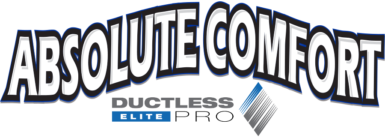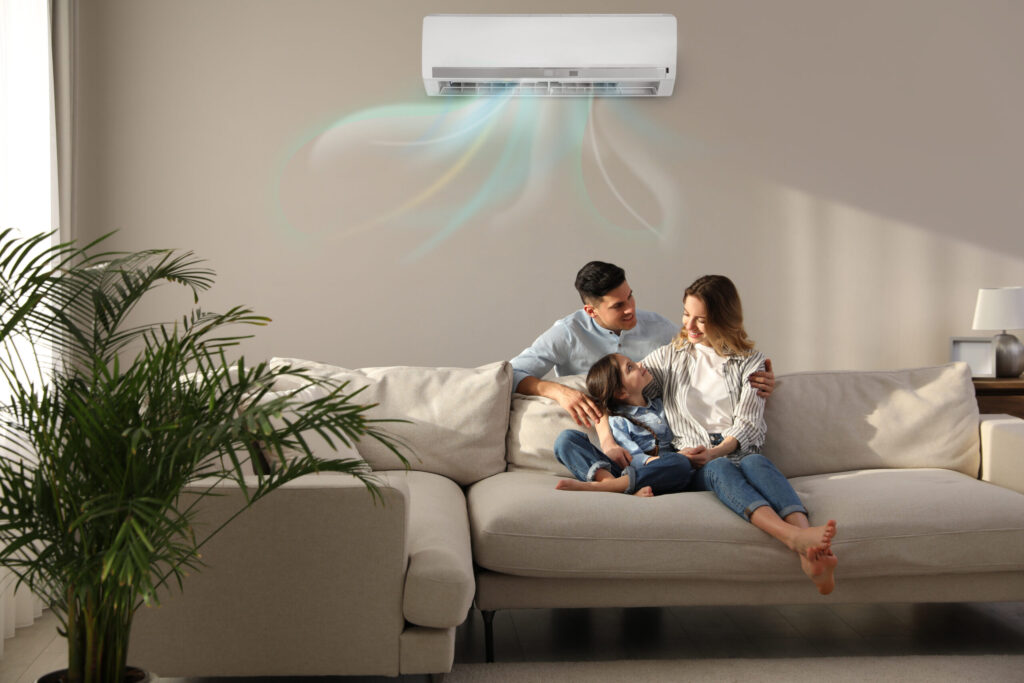Ductless mini-splits are becoming a go-to comfort solution in Central Indiana, from bonus rooms in Westfield to historic homes in Indianaplois. Whether you’re exploring a new install or just curious about the technology, this FAQ has you covered with clear, helpful answers from certified local pros.
How does a ductless mini-split system work?
The simple answer: A ductless mini-split consists of two main components—an indoor air handler and an outdoor condenser unit connected by a small conduit.
- No ductwork needed means zero energy loss through leaky ducts (traditional systems can lose up to 35% of their efficiency through ductwork)
- Zoned control allows you to set different temperatures in each room
- Quiet operation with noise levels as low as 19 decibels—quieter than a whisper
- Direct delivery of conditioned air eliminates the inefficiencies of traditional ducted systems
The outdoor unit houses the compressor and condenser, while the sleek indoor unit mounts on your wall or ceiling to distribute perfectly conditioned air exactly where you need it.
How energy efficient are ductless systems?
Bottom line: Modern ductless systems are incredibly efficient, with SEER ratings typically ranging from 18-30+ compared to the federal minimum of 15.
- SEER ratings for quality systems like Mitsubishi often exceed 20, with premium models reaching 33+ SEER
- Inverter technology allows the compressor to adjust speed based on demand, using only the energy needed
- Lower monthly energy bills because mini-splits use up to 40% less energy than window units
- Perfect for retrofitting older homes in Greenwood and Carmel without existing ductwork
Mitsubishi systems frequently achieve SEER ratings exceeding 20, with some premium models reaching 33.1 SEER, making them among the most energy-efficient options available.
Can one ductless unit cool an entire house?
Short answer: Not usually—mini-splits work best for targeted zone cooling or specific additions.
- Single units are ideal for bonus rooms, sunrooms, garages, or challenging spaces your central system can’t reach
- Multi-zone systems can handle whole-home comfort using one outdoor unit connected to multiple indoor units
- Typical coverage ranges from 300-1,500 square feet per indoor unit, depending on capacity and home efficiency
- Best applications include upstairs bedrooms that run hot, three-season rooms, or home additions
For whole-home solutions, most Indiana homes need 2-4 indoor units strategically placed to provide comprehensive comfort.
What’s involved in installing a ductless system?
Installation is surprisingly simple: Most single-zone installations take just one day with minimal disruption.
- Quick setup typically completed in 4-8 hours by certified professionals
- Wall-mount or ceiling cassette options to fit your space and aesthetic preferences
- Minimal home disruption compared to installing ductwork—just a small hole through the wall
- No major renovations needed, making it perfect for historic Indiana homes
The installer mounts the indoor unit, places the outdoor condenser, and connects them through a small conduit carrying refrigerant lines, electrical wiring, and a condensate drain.
Why ductless mini-splits beat all other cooling alternatives
Mini-splits outperform every other cooling option available to Indiana homeowners.
vs. Window AC Units:
Major Problems with Window Units:
- Moisture & Health Issues: Condensation damage to walls and window frames from improper drainage; mold and mildew growth inside units creating poor air quality
- Security Vulnerabilities: Easy burglar access—criminals can push units inward or remove them to enter homes; police warnings about window ACs being “welcome mats” for burglars
- Functionality Issues: Block natural light and obstruct window views; difficult emergency egress if AC blocks the only window
- Short lifespan: 8-10 years vs. 15-20 years for mini-splits
vs. Portable AC Units:
Why Portable ACs Fall Short:
- Extremely noisy operation (compressor is indoors) vs. whisper-quiet mini-splits
- Poor energy efficiency with EER ratings under 10 vs. mini-splits’ 20+ SEER ratings
- Takes up valuable floor space and requires constant maintenance
- Frequent water emptying required from condensation collection
- Short 7-10 year lifespan and frequent repairs
- Limited cooling capacity struggles with larger spaces
- Bulky exhaust hoses obstruct windows and doors
vs. Central Air Retrofits:
Central Air Retrofit Challenges in Older Indiana Homes:
- Massive installation costs: $6,000-$20,000+ for homes without existing ductwork
- Invasive construction: Tearing apart walls, lowering ceilings, and destroying architectural features
- Space constraints: Many historic Indiana homes lack space for traditional 6″-12″ wide ductwork
- Extended installation time: 3-5 days of construction disruption vs. 1 day for mini-splits
- Ductwork problems: Up to 35% energy loss through leaky ducts in older homes
- Structural complications: Plaster walls and elaborate woodwork obstruct installation
Mini-Split Advantages:
- Energy Efficiency: 40% less energy than window units, 20+ SEER ratings
- Quiet Operation: 19-30 dB vs. noisy alternatives
- Quick Installation: One day vs. weeks of construction
- Zoned Control: Heat/cool only occupied spaces
- Long Lifespan: 15-20 years with proper maintenance
- No Security Risk: Unlike window units that compromise home safety
- Preserves Architecture: Perfect for Indiana’s historic homes
Do ductless mini-splits work in Indiana winters?
Absolutely—modern systems are designed for cold climates and work reliably in Indiana’s winter conditions.
- Cold-climate models like Mitsubishi’s Hyper-Heating technology maintain 100% heating capacity down to 5°F
- Continued operation even at temperatures as low as -13°F to -22°F (though at reduced capacity)
- Many successful installations in rural Indiana homes with no backup heat source
- Superior to traditional heat pumps which struggle below 30°F
Modern cold-climate mini-splits can maintain 100% heating capacity at 5°F and continue operating at temperatures as low as -13°F, making them suitable for Indiana’s winter conditions.
Pro tip: Ask your installer about cold-climate rated models specifically designed for Midwest winters.
How long do ductless systems last?
With proper maintenance, expect 15-20 years of reliable service—often outlasting traditional HVAC systems.
- Average lifespan of 15-20 years with regular maintenance
- Premium brands like Mitsubishi can last up to 25+ years
- Longer than window units which typically last 8-10 years
- Simpler design means fewer components to break down
Well-maintained ductless systems typically last 15-20 years, with some high-quality systems reaching up to 20+ years of service life.
Investment protection: Professional maintenance and quality installation significantly extend system lifespan.
How do I maintain a mini-split system?
Maintenance is straightforward and less complex than traditional HVAC systems.
Monthly tasks:
- Clean indoor unit filters (washable and reusable)
- Check for debris around outdoor unit
Seasonal maintenance:
- Schedule professional tune-ups twice yearly—before heating and cooling seasons
- Professional cleaning of coils and refrigerant level checks
- Electrical connection inspection
Benefits of regular maintenance:
- Professional maintenance twice yearly helps prevent bigger, more expensive repairs and extends system lifespan
- Maintains peak energy efficiency
- Preserves warranty coverage
The simple design means no ductwork to clean or complex systems to maintain—just basic filter care and annual professional service.
Ready to Experience Ductless Comfort?
Ductless mini-splits offer an efficient, versatile way to boost comfort in your Indiana home—especially for challenging spaces or renovations. Whether you’re dealing with a hot upstairs, adding onto your home, or looking to upgrade an older property without ductwork, mini-splits provide targeted comfort with impressive energy savings.
Ready to explore if a mini-split is right for your home? Schedule a free in-home consultation with Absolute Comfort today. Our certified technicians will assess your specific needs and provide expert guidance on the best solution for your Central Indiana home.

